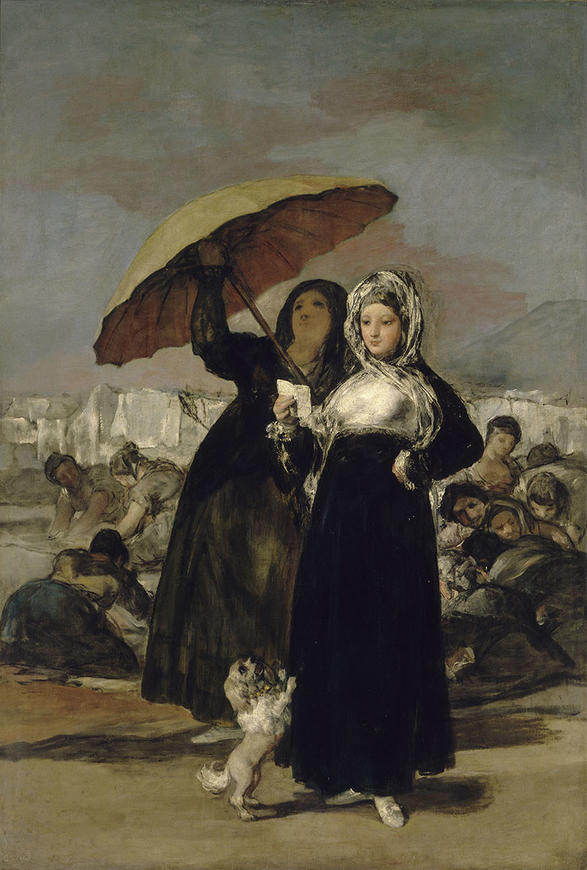A beautiful young lady is taking a walk. She is sheltered from the sun by a parasol held by her maid. This maja - a Spanish woman dressed elegantly - is reading a letter. A shopping list? No. of course not! A love letter, no doubt. But look carefully at her attitude - she smiles, her fist resting on her hip - we suspect she is making fun of what her lover has written to her!
This painting of this couple, this arrogant young woman with her servant, is treated with great precision. Now look at the background of the painting. A group of women - laundresses - are busy working. They are bent over and exhausted from washing linen in the river. Goya brushes them in broadly. They could never be recognised by their faces. Is this a way of showing that at the time these women belonged at the bottom of the social ladder? The difference in treatment between the two groups suggests this.
This painting hangs next to another work by Goya, Les Vieilles, The Old Ones. In the XIXth century, it was thought that two Goyas hanging together was better than two Goyas hanging apart. Everything was done to present these two paintings as though they were counterparts of each other: identical frames, the enlargement of the Les Vieilles so that the work reached the same dimensions as Les Jeunes... But don't be taken in, Les Vieilles was painted several years before Les Jeunes!
Inventory number: P.9
Details : The unfinished aspect of the background reminds one of the works of the painter Edgar Degas. He regarded Goya as a modern painter and he was greatly inspired by him!

A beautiful young lady is taking a walk. She is sheltered from the sun by a parasol held by her maid. This maja - a Spanish woman dressed elegantly - is reading a letter. A shopping list? No. of course not! A love letter, no doubt. But look carefully at her attitude - she smiles, her fist resting on her hip - we suspect she is making fun of what her lover has written to her!
This painting of this couple, this arrogant young woman with her servant, is treated with great precision. Now look at the background of the painting. A group of women - laundresses - are busy working. They are bent over and exhausted from washing linen in the river. Goya brushes them in broadly. They could never be recognised by their faces. Is this a way of showing that at the time these women belonged at the bottom of the social ladder? The difference in treatment between the two groups suggests this.
This painting hangs next to another work by Goya, Les Vieilles, The Old Ones. In the XIXth century, it was thought that two Goyas hanging together was better than two Goyas hanging apart. Everything was done to present these two paintings as though they were counterparts of each other: identical frames, the enlargement of the Les Vieilles so that the work reached the same dimensions as Les Jeunes... But don't be taken in, Les Vieilles was painted several years before Les Jeunes!
Inventory number: P.9
Details : The unfinished aspect of the background reminds one of the works of the painter Edgar Degas. He regarded Goya as a modern painter and he was greatly inspired by him!